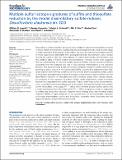Multiple sulfur isotope signatures of sulfite and thiosulfate reduction by the model dissimilatory sulfate-reducer, Desulfovibrio alaskensis str. G20
Author(s)
Leavitt, William D.; Cummins, Renata; Schmidt, Marian L.; Ono, Shuhei; Bradley, Alexander S.; Johnston, David T.; Sim, Min Sub; ... Show more Show less
DownloadLeavitt-2014-Multiple sulfur isot.pdf (2.191Mb)
PUBLISHER_CC
Publisher with Creative Commons License
Creative Commons Attribution
Terms of use
Metadata
Show full item recordAbstract
Dissimilatory sulfate reduction serves as a key metabolic carbon remineralization process in anoxic marine environments. Sulfate reducing microorganisms can impart a wide range in mass-dependent sulfur isotopic fractionation. As such, the presence and relative activity of these organisms is identifiable from geological materials. By extension, sulfur isotope records are used to infer the redox balance of marine sedimentary environments, and the oxidation state of Earth's oceans and atmosphere. However, recent work suggests that our understanding of microbial sulfate reduction (MSRs) may be missing complexity associated with the presence and role of key chemical intermediates in the reductive process. This study provides a test of proposed metabolic models of sulfate reduction by growing an axenic culture of the well-studied MSRs, Desulfovibrio alaskensis strain G20, under electron donor limited conditions on the terminal electron acceptors sulfate, sulfite or thiosulfate, and tracking the multiple S isotopic consequences of each condition set. The dissimilatory reduction of thiosulfate and sulfite produce unique minor isotope effects, as compared to the reduction of sulfate. Further, these experiments reveal a complex biochemistry associated with sulfite reduction. That is, under high sulfite concentrations, sulfur is shuttled to an intermediate pool of thiosulfate. Site-specific isotope fractionation (within thiosulfate) is very large (34ε ~ 30‰) while terminal product sulfide carries only a small fractionation from the initial sulfite (34ε < 10‰): a signature similar in magnitude to sulfate and thiosulfate reduction. Together these findings show that microbial sulfate reduction (MSR) is highly sensitive to the concentration of environmentally important sulfur-cycle intermediates (sulfite and thiosulfate), especially when thiosulfate and the large site-specific isotope effects are involved.
Date issued
2014-11Department
Massachusetts Institute of Technology. Department of Earth, Atmospheric, and Planetary SciencesJournal
Frontiers in Microbiology
Publisher
Frontiers Research Foundation
Citation
Leavitt, William D., Renata Cummins, Marian L. Schmidt, Min S. Sim, Shuhei Ono, Alexander S. Bradley, and David T. Johnston. “Multiple Sulfur Isotope Signatures of Sulfite and Thiosulfate Reduction by the Model Dissimilatory Sulfate-Reducer, Desulfovibrio Alaskensis Str. G20.” Frontiers in Microbiology 5 (November 25, 2014).
Version: Final published version
ISSN
1664-302X